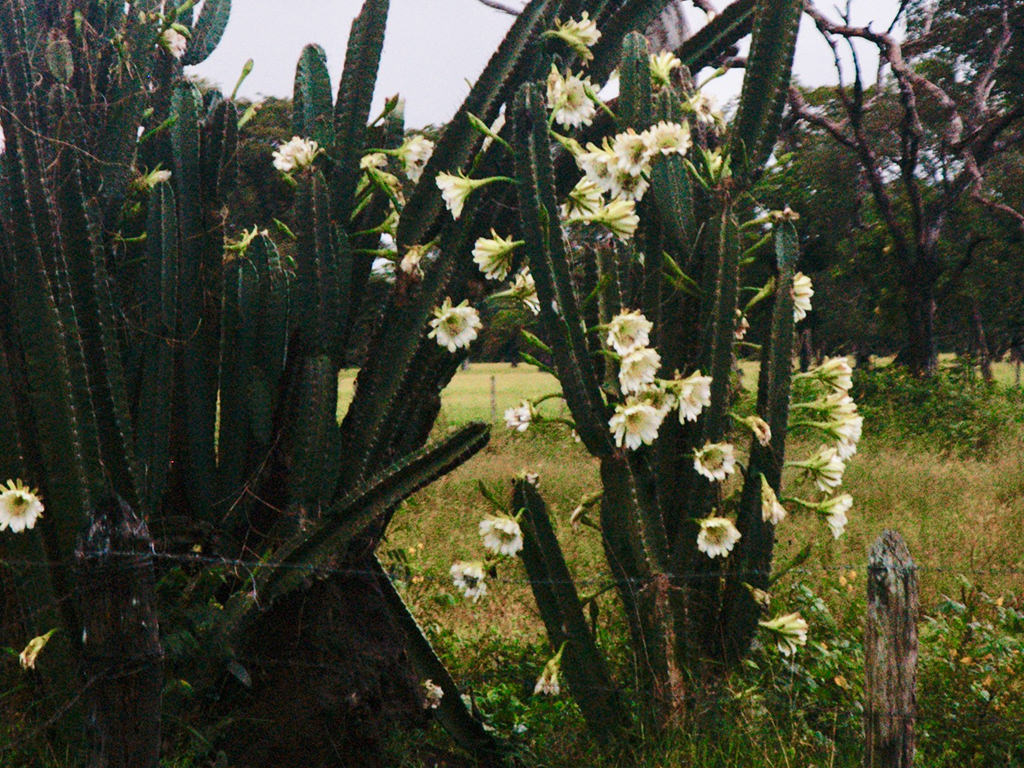Scientific Name
Cereus bicolor Rizzini & A.Mattos
Scientific Classification
Family: Cactaceae
Subfamily: Cactoideae
Tribe: Cereeae
Genus: Cereus
Origin
This species is native to Brazil (Mato Grosso do Sul).
Description
Cereus bicolor is a rare shrubby cactus with blue-green branches with 7 or 8 ribs and areoles covered with white wool that bear clusters of bicolor spines. It grows up to 10 feet (3 m) tall. The branches are up to 3 feet (90 cm) tall and up to 3.6 inches (9 cm) in diameter. Each areole bears 3 to 5 central and 6 to 8 radial spines. The nocturnal flowers are white and up to 8 inches (20 cm) long. Edible fruits are spherical to egg-shaped and usually red.
Etymology
The specific epithet "bicolor (BY-kul-ur)" is a Latin compound adjective meaning "of two colors" or "having two colors" and probably refers to the bicolored spines. It is a compound of two words, the adverb "bis," meaning "twice," "two times," "on two occasions," or "in two ways," and the noun "color," meaning "color" or "hue."

How to Grow and Care for Cereus bicolor
Light: This cactus likes full sun. It can handle partial shade but thrives in direct sunlight during the summer. A sunny window is a good spot to grow C. bicolor indoors. Rotate the pot a quarter turn every week or two to encourage balanced growth. If possible, get your cactus outdoors from spring to fall.
Soil: C. bicolor does not like to have "wet feet" and needs to be grown in well-draining soil. Use commercial soil mixes for cacti or make your own mix.
Hardiness: During the active growth period, this cactus likes warm temperatures, while in winter, it likes cooler temperatures. C. bicolor can withstand temperatures as low as 30 to 50 °F (-1.1 to 10 °C), USDA hardiness zones 10a to 11b.
Watering: From spring to fall, water thoroughly, but allow the soil to dry out before watering again. With the arrival of fall, gradually reduce the watering frequency. During the winter, when C. bicolor is dormant, give it just enough water to prevent shrinking.
Fertilizing: During its growing season, this cactus likes regular fertilizing. A balanced, water-soluble fertilizer, diluted to 1/4 strength, can be added to the water for each watering. A 10-10-10 fertilizer is ideal. Instead of making a solution of water and fertilizer, there are also dry fertilizers. Do not fertilize during the winter.
Repotting: While C. bicolor is young, it is recommended to repot each year in early spring. Once it matures, repot when your cactus is outgrowing its pot.
Propagation: Using stem cuttings is the easiest method to propagate C. bicolor because seed propagation is a slow process. Planting of the cuttings is best done when the cactus is actively growing. Spring and summer is the best time to sow the seeds.
Learn more at How to Grow and Care for Cereus.
Toxicity of Cereus bicolor
C. bicolor is non-toxic to humans or animals.
Links
- Back to genus Cereus
- Succupedia: Browse succulents by Scientific Name, Common Name, Genus, Family, USDA Hardiness Zone, Origin, or cacti by Genus
Photo Gallery
Click on a photo to see a larger version.



